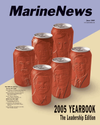
Page 26: of Marine News Magazine (June 2005)
Read this page in Pdf, Flash or Html5 edition of June 2005 Marine News Magazine
Anderson: If I were king, I would decree that lawmakers view transportation infrastructure as an economic engine that drives the economy, not the other way around. So rather than quibbling about the numbers and model used to project traffic growth on the Upper Mississippi
River System, we should recognize that all parties agree there will be significant traffic increases in the next 50 years and build with that in mind.
Recent figures from the Minnesota
Department of Transportation (MNDOT) show that in 2003 farmers from that state shipped 7,457,309 tons of corn, wheat and soybeans to the gulf in barges at an esti- mated $11.45 per ton. A similar rail trip would have cost $20.33, which MNDOT says translates into savings of $66,220,904 for farmers using the water- way. Barge rates also put pressure on freight costs well beyond the reach of the system. If we want this economic engine to keep working for Midwest farmers and other shippers, we must fund the seven new locks called for in the Water
Resources Development Act (WRDA) recently introduced by Missouri Senator
Kit Bond. To me it's a bit like the line from the movie" "If you build it, they will come." And they'll be here before we know it.
MN: What are some of the bottlenecks that exist on the system?
Anderson: Those of us on the upper end of the Mississippi River system have more than our share of problem areas and single-chamber, 600-foot locks. One that is of special concern is Lock and Dam 3 at
Red Wing, Minn. When The Corps' Mis- sissippi Valley Division leader Brigadier
General Robert Crear was in St. Paul recently, he told local river industry lead- ers that the long delayed work to correct embankment and outdraft problems is now considered a "new start" because of the delay. He also indicated that work is part of a "significant backlog" of under funded O&M projects.
The need for the work was reinforced recently when eight barges filled with cement were caught in the outdraft and struck the roller gates. The Corps says that the lock's position on a river bend tends to sweep tows away from the lock and toward the gates. The recent incident makes 12 accidents since 1968. There's also worry about losing the pool if one of the 3 embankments on the Wisconsin side lets go. The WRDA bill I just talked about identifies the other bottlenecks of concern that will be remedied with 1,200 foot locks at Locks 20,21,22, 25 and 25 on the
Mississippi.
Raymond Butler •
GICA
MN: What is the most important message about the inland waterways industry that needs to be conveyed to the media and policymakers?
Butler: The Inland Waterways Industry 26 • MarineNews • June, 2005
You’ve known us for quality rigging products since 1890. Our compre- hensive block, fairlead, sheave and alloy forging lines have met the chal- lenges of the most demanding appli- cations around the world. And in the process, we’ve proudly taken part in the shaping of American history; from salvage operations at Pearl
Harbor and construction of the Grand Coulee Dam to
San Francisco’s BART and the space shuttle.
Whatever your applications, we’re committed to serving you with the finest in standard and custom engineered products. For further information contact your nearest dealer or call us at: 503/651-3175
Skookum
PO Box 280, Hubbard, OR 97032
FAX 503/651-3409
Now more than ever,
Skookum signifies value in today’s cost-conscious world.
Blocks & Rigging
AN ULVEN COMPANY 1-800-547-8211 www.skookumco.com
SINCE 1890
Circle 274 on Reader Service Card
Circle 223 on Reader Service Card
Circle 263 on Reader Service Card
Circle 236 on Reader Service Card
CEO SIX PACKTHE YEARBOOK
JUNEMN2005 4(25-32).qxd 5/25/2005 8:15 PM Page 26

 25
25

 27
27
